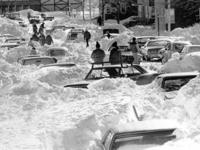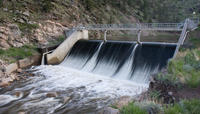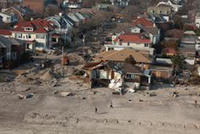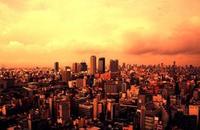-
Northeast U.S. digs out after deadly snowstorm

About 250,000 homes and businesses in northeast United States remain remained without power this morning as a blizzard dumped more than three feet of snow on north-mid-Atlantic and New England states, and parts of Canada. The death toll was at fifteen. Utilities in New England said the storm could leave some customers in the dark at least until Tuesday. About 650,000 lost power in eight states at the height of the storm.
-
-
Idaho debating nuclear waste storage
For two decades, the Yucca mountain nuclear waste repository in Nevada was viewed as a long-term solution to the growing problem of radioactive waste generated by the 104 active nuclear power generation plants in the United States. One of the Obama administration’s first acts was to “defund” the project, in effect outing an end to it. States such as Texas, New Mexico, and North Carolina have fashioned their own interim solution to the problem of nuclear waste storage, and the governor of Idaho wants his state to follow these states’ example.
-
-
Tiny organisms in oceans can save islands from rising sea levels: study

Warming climate is causing sea levels to rise, posing a special threat to low-lying island nations. The government of the Maldive Islands, an island nation in the Indian Ocean consisting of a chain of twenty-six atolls, has begun exploring the possibility of purchasing land in Africa to relocate the entire population – about 330,000 – once rising sea water begin to swallow the small atolls. Scientists found out, though, that the warming temperature of the seas is causing tiny single-cell organisms to are spreading rapidly through the world’s oceans, where they just might be able to mitigate the consequences of climate change.
-
-
Hydroelectric power generation superior to nuclear and coal, beats oil and gas

Researchers have reviewed the economic, social, and environmental impact of hydro, coal, oil, gas, and nuclear power. Each has its advantages and disadvantages, but of these conventional electricity generation technologies, hydroelectric power appears to be the most sustainable and acceptable environmentally and economically.
-
-
Old, faulty bores jeopardize Australia's water
Australian homes, towns, cities, farmers, and miners will rely increasingly on underground water as the country’s population grows, surface water supplies dwindle, and as droughts multiply under a warming climate. Trouble is, the authorities in charge do not have a clear idea exactly how much groundwater there is, how rapidly it is recharged — or how quickly it is being depleted. What is known is based on data largely supplied by 23,000 monitoring bores spread across the continent — more than two thirds of which are now falling into disrepair.
-
-
New internally cured concrete increases bridge life span
Concrete is normally made by mixing portland cement with water, sand, and stone. In the curing or hardening process, water helps the concrete mixture gain strength by reacting with the cement. Traditionally, curing is promoted by adding water on top of the bridge deck surface. The new technology for internal curing provides additional water pockets inside the concrete, enhancing the reaction between the cement and water, which adds to strength and durability. This new technology is enabling Indiana to improve bridges in the state with a new “internally cured” high-performance concrete.
-
-
NY to buy, demolish beachfront homes, make way for storm buffers

New York governor Andrew Cuomo plans to use $400 million in federal funding to buy beachfront homes as part of a broader plan to reshape the New York coastline so the state is better prepared for sea level rise, surges, and storms. The plan is to raze the purchased homes and leave to shore front vacant. Some properties would be turned into dunes, wetlands, or other natural buffers. Other parcels could be combined and turned into public parkland.
-
-
Miles tax may soon replace gas tax as a way to fund infrastructure maintenance
With infrastructure around the country in a state of disrepair, many states and lawmakers are trying to find a way to fund improvement of roads and bridges. The federal gasoline tax brings in fewer dollars each year, and now some lawmakers and transportation experts are considering the idea of taxing citizens by how far they drive each year instead of the amount of gasoline they buy each year.
-
-
Springfield, Illinois, faces infrastructure woes
As is the case with other cities, the infrastructure of Illinois’ capital, Springfield, is decaying. Experts told the city council that it would take $86.6 million over the next three years to shore up the city’s streets and sewer system, and $22.5 million a year thereafter to maintain it. The city is now grappling with how to raise the necessary funds.
-
-
New clean coal technology provides energy without burning
A new form of clean coal technology reached an important milestone recently, with the successful operation of a research-scale combustion system. The technology is now ready for testing at a larger scale. For 203 continuous hours, the combustion unit produced heat from coal while capturing 99 percent of the carbon dioxide produced in the reaction.
-
-
Novel nanosized antenna arrays key to effective harvesting of solar energy
For years, scientists have studied the potential benefits of a new branch of solar energy technology that relies on incredibly small nanosized antenna arrays that are theoretically capable of harvesting more than 70 percent of the sun’s electromagnetic radiation and simultaneously converting it into usable electric power. A novel fabrication technique could provide the breakthrough technology scientists have been looking for to improve today’s solar energy systems.
-
-
Wastewater from fracking is often highly radioactive
New studies have found that waste from fracking operations can be highly radioactive. A geological survey reported that millions of barrels of wastewater from unconventional wells in Pennsylvania and conventional wells in New York are 3,609 times more radioactive than the federal limit for drinking water, and 300 times more radioactive than a Nuclear Regulatory Commission limit for nuclear plant discharges.
-
-
Climate change threatens public health, safety, economy along U.S. coasts
A new technical study from the U.S. National Oceanic and Atmospheric Agency (NOAA) and the U.S. Geological Survey (USGS) reports that the effects of climate change will continue to threaten the health and vitality of U.S. coastal communities’ social, economic, and natural systems. All U.S. coasts are highly vulnerable to the effects of climate change such as sea-level rise, erosion, storms, and flooding, especially in the more populated low-lying parts of the U.S. coast along the Gulf of Mexico, Mid-Atlantic, northern Alaska, Hawaii, and island territories. The report says that the financial risks associated with both private and public hazard insurance are expected to increase dramatically.
-
-
Osaka Basin quake map identifies high-rise buildings at risk

The Osaka Basin, Japan is home to many high-rise buildings which sit atop its thick soft sediments, vulnerable to long-period strong ground motions that last minutes. A new map created by Japanese researchers is intends to guide engineers and city planners in new construction and identifies existing buildings with the potential of resonance vibration.
-
-
New bridge construction technologies to shore up U.S. infrastructure
Experts agree that there is an urgent need to construct and repair bridges across the United States. Around 70,000 bridges in the country are considered “structurally deficient” by government standards. New technology could help the United States manage its growing, and aging, infrastructure without breaking the bank or levying high taxes on citizens.
-
More headlines
The long view
Helping Strengthen America’s Critical Infrastructure
Everyday life depends on a robust infrastructure network that provides access to running water, communications technology and electricity, among other basic necessities. The experts who keep our national infrastructure secure and resilient also need a strong network to share their knowledge and train the next generation of professionals capable of solving complex infrastructure challenges.
AI and the Future of the U.S. Electric Grid
Despite its age, the U.S. electric grid remains one of the great workhorses of modern life. Whether it can maintain that performance over the next few years may determine how well the U.S. competes in an AI-driven world.
Using Liquid Air for Grid-Scale Energy Storage
New research finds liquid air energy storage could be the lowest-cost option for ensuring a continuous power supply on a future grid dominated by carbon-free but intermittent sources of electricity.
Enhanced Geothermal Systems: A Promising Source of Round-the-Clock Energy
With its capacity to provide 24/7 power, many are warming up to the prospect of geothermal energy. Scientists are currently working to advance human-made reservoirs in Earth’s deep subsurface to stimulate the activity that exists within natural geothermal systems.
Experts Discuss Geothermal Potential
Geothermal energy harnesses the heat from within Earth—the term comes from the Greek words geo (earth) and therme (heat). It is an energy source that has the potential to power all our energy needs for billions of years.
